CiM Tester Feedback
-
Testers generally agreed that Canyon de Chelly is easy to strike but it is difficult to reproduce the same hues each time.
"It will strike beautifully if you are careful. It is more just flashing it in the flame after it cools some, after the glow is gone. You can even just flash small areas on a larger bead and get areas to change color. Marvering and then flashing also works well." – Tim Gottleber
"Canyon de Chelly strikes and unstrikes very easily. Any type of heating and cooling action will do. I think medium heat gets the best reaction. The colors and effects you can get from Canyon appear to be limitless by changing the rate at which you heat and cool, and what temperature you work it in. On the positive side, it is really easy to get the striking colors- and they are beautiful! On the negative side, it is also really easy to unstrike the colors that you just got and your bead can get blotchy if you accidentally heated up an area that you struck." – Bethany Lemasters
“The strike of Canyon de Chelly is very exciting because every time creates a different hue. This is what makes it so popular / a top seller.” – Angela Hadorn
“Part of the appeal of Canyon de Chelly for me is the surprise factor – I never know exactly what I will get but it will all look interesting. Because I like this variation, I have never really tried hard to get Canyon to strike one consistent color.” – Carol Oliver
“I have a terrible time striking Canyon de Chelly. I have been playing with other striking glasses, such as Gaffer’s Chalcedony, or Reichenbach’s Magic and Iris Orange. I have had easier, more reproducible results with these other glasses. I do use Canyon quite a bit. I just don’t make the effort to get the more intense colors that I see some people getting. I use it because of the variation in color that I can get.” – Chris Haussler
"Canyon de Chelly is difficult to strike to anything other than a creamy caramel. When colors were struck they seemed to disappear after annealing. Seemed to like spot/heating/striking to get color variations.” – Claire Morris
“CDC is its own self, you really never know what color you'll get, and that's part of its charm for me. Colors range from light or dark grays, browns, tans, all in one glass that is fabulous alone. It seems once you strike and get the colors you want, you have to stop then, otherwise it's just 'yellow-brown'; you can't restrike to other colors in my experience once it goes to that." – Elasia
“I have been able to strike this color, but have had issues reproducing the same hue. Usually this isn’t a problem.” – Gail Witt
"You have to really pay attention when striking this glass. It's somewhat difficult to get the same colors every time." – Teri Yount
“I’m still not getting consistent colors from Canyon de Chelly, but that is NOT a bad thing! I avoid using it in designs where exact colors are required, and love the organic nature of colors that produce a wide range of uncontrolled/unexpected hues.” – Kathy Coon
“I found Canyon de Chelly easy to strike to the same hue. I actually made 3 beads on the same mandrel and teased them differently. When they went into the kiln, they all had a different hue, but when I took them out they were quite similar.” – Maija-Leena Autio
"It was very difficult to reproduce hues each time.” – Kirsty Naray
“Unfortunately, I wasn’t able to replicate the same hue on demand. I tried 3 times and got 2 the same and the original one was never matched. But the colors are still quite lovely and it is such a pretty glass.” – Marcy Lamberson
"The colour of Canyon de Chelly, depending on how much you strike it and what you put it with ranges from a pale, tawny tan to a rich, variegated gold. It can also look a little more dusky, and be struck to a more pinkish/purply hue." Read more at Melanie's blog. – Melanie Graham
-
Testers agreed that Canyon de Chelly is one of our best selling colors because it works so well with silver & reactive glasses.
"I rolled Canyon de Chelly in copper and silver foil in a reduction flame. I love the way the foils reacted with the CDC, and how vibrantly the other colors I used ‘popped’ on it, they almost look like I fumed them! CDC turned beautiful colors like Raku, but softer, and more subtle. I also love it reduced with my reactive glass.” – Vonna Maslanka
“Canyon de Chelly is a great neutral color, similar to Effetre Sage. It melts beautifully, doesn’t burn, and reacts well with silver. In fact, I liked the color of the glass more when I used it with silver glass or silver foil. It turned a darker caramel color that I thought had more depth. I would see the purples and yellows when I melted the glass, but they disappeared as it cooled. I did get one bead to show some color variation that didn’t have any silver with it, and I didn’t think it was very pretty.” – Gail Witt
“Canyon de Chelly is an intriguing reactive glass with potential. It reacts to itself, creating a record of the glass additions, as well as reacting to other glasses. Canyon de Chelly reacts beautifully with copper and silver foils in a reduction or neutral flame. Dark caramel, cinnamon, and baked pumpkin tones!" – Bonnie Polinski
-
Many testers reported that marvering with brass brought out more of Canyon de Chelly's colors.
“Canyon de Chelly seemed to like brass, and color variations were noted when touched with a brass tool.” – Claire Morris
“Marvering or pressing with cool brass brought out the colors.” – Tina Lamasney
“It reacted to the brass marver at first then the reaction was lost after I annealed the beads.” – Vonna Maslanka
“When squishing with my mashers, the chill marks were lighter or tan. So I tried heating and touching it to cold metal and those spots did react.” – Elasia
“Colors flashed beautifully at the torch and when the glass was pressed or prodded with a cool tool or marver, but most of the color I saw at the torch was no longer there after the beads came out of the kiln. I marvered it on brass, copper, and graphite to see if the results would differ. I got the best results so far when I lightly reheated the beads in a reduction flame after pressing hard while marvering. It did not seem to matter what I marvered on.” – Bonnie Polinski
-
Many testers expressed disappointment that they could not replicate the hues that other lampworkers achieved.
“I thought I would get a broader range of color.” – Tina Lamasney
"Without reducing or adding silver, I found Canyon de Chelly a bit insipid and hard to work well with on anything else except organics and an animal bead. To get interesting colors it took a lot of work and I am not sure if its worth it to be honest. The color is hard to design with.” – Claire Morris
“I don’t make a lot of organic beads and tend to use brighter colors, but this glass is a nice base color or accent color. I didn’t like the color as much as Effetre Sage.” – Gail Witt
-
Special thanks to Tim Gottleber, Bethany Lemasters, Elasia (x3), Trudi Doherty & Vonna Maslanka for providing the photos in this section.
"Canyon de Chelly is the perfect color for tawny colored animals, especially big cats! The accent on the nose and around her mouth is CiM Mink."
– Tammy Mercier
|
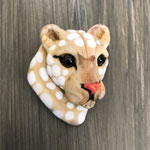
|
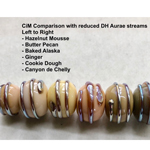
| CiM comparison with reduced DH Aurae streams. See more at Darlene's blog. |
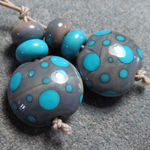
| Canyon de Chelly & Smurfy.
–
Jolene Wolfe
|
"Delightful! I made no particular attempt to strike it - other than the heating and cooling that is a result of working these shapes. The variability is wonderful!" Read more at DragonJools' blog. |
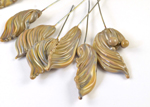
|
Learn how to make acorns with Canyon de Chelly in Sandy Kelly’s “Acorn and Oak Leaf Lentils” tutorial in the January 2013 issue of Soda Lime Times. |
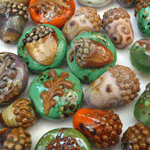
|
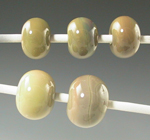
| "The latest batch to arrive is significantly grayer in the rod than the last batch . . . This picture is a little underexposed, but shows better the variability and a lot of the subtle colours in the glass." Read more at DragonJools blog. |
"The base bead was red roof tile, and it has the Canyon de Chelly twistie [with stripes of Lauscha olive & Ekho] on top. It’s interesting and again organic but more subtle this time." See more at Heather's blog. |
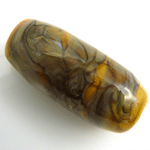
|
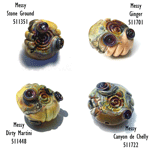
| "I did a color study called 'Other than Ivory' using some Messy Colors in those wonderful earthy tones." Read more at Genea's blog. |
Canyon de Chelly face cabochons with varying re strike amounts.
– Robert Jennik
|
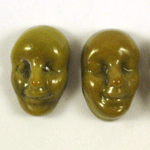
|
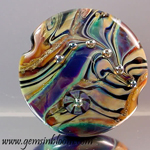
| "I have used Canyon de Chelly for just about every type of bead I make, minus encased florals. It adores silver.........so slap some silver foil or leaf on the surface. I prefer foil due to ease of use. So it would make sense that it also loves silver glasses. I also use it without foil. I roll it in frit. I create twisties with it. Canyon makes lovely shards. Basically it is a lovely neutral reactive base glass."
–
Jacqueline Parkes
|
"I have read a lot about Canyon de Chelly and have tried it here and there but I never got anything exciting out of it. I came across Karolen's post on her blog showing her favorite combinations with this glass so I made a few using her suggestions [with turquoise, opal yellow, silver foil, etc.] Read & see more at Chris's blog. |
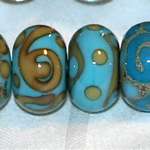
|
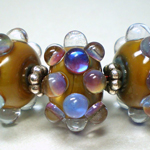
| "This mini set of 5 beads was created on a base of CiM's silver brown, Canyon de Chelly. Decorations of Double Helix silver glass, Terra 2, were added, reduced, encased with Effetre clear and re-struck to create the dramatic hues of pinks, blues, ambers and purples." Read more at Darlene's blog. |
Nest made with Canyon de Chelly.
– Genea Crivello
|
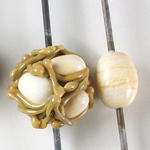
|
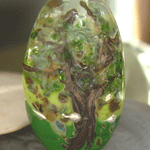
| "Canyon de Chelly is the perfect color to use with black and brown colors for pulling tree stringer. It lightens the brown shades without ranging them and establishes a highlight line on the stringer, adding visual depth to the designs."
–
Bonnie Polinski
|
"Canyon de Chelly reacts with itself. A halo of black formed around fresh additions of CDC as I added them to my initial CDC bead."
– Bonnie Polinski
|
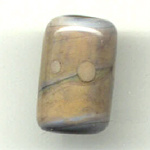
|
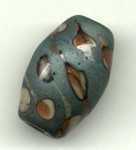
| “A halo of black around the Canyon de Chelly was created when I applied it to a bead of Effetre hand pulled Red Green Copper #1556-219B in a neutral flame."
–
Bonnie Polinski
|
Canyon de Chelly with Gaffer Chalcedony frit.
– Carol Oliver
|
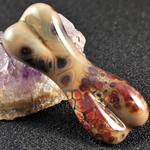
|
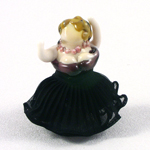
| Messy Canyon de Chelly for hair.
–
Lisa Rippee
|
"Silver glass can be fussy...but when the right reaction comes along, it knocks your socks off! Sometimes it's a guessing game to find the right combination of colors, how often to strike and cool the glass, and how long to anneal it. For me, Canyon de Chelly takes a lot of the 'guesswork' out of the equation. Especially when used as a base for striking colors, like DH's Luna, and this experimental glass called 'Dalai Lotus' by Trautman Art Glass, the colors seem to just come alive all by themselves! I've found that Canyon de Chelly works like a charm in bringing out the stunning array of colors from silver glass, that in the past were so elusive to me. I keep a stack of it by my bench so it is always within reach!"
– Alison Dvorchik
|
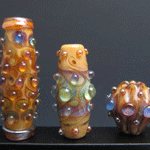
|
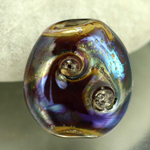
| Psyche over Canyon de Chelly with clear dots.
–
Lea Avroch
|
"I found that by warming this bead gently in the back of the flame after letting it become cool enough to be covered with the silver leaf allowed me to easily strike the Canyon de Chelly to its deeper shade."
– Jolene Wolfe
|
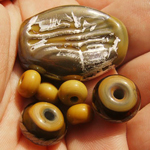
|
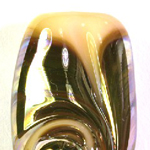
| Canyon de Chelly with Aurae.
–
Sue Stewart
|
"Copper Green spreads on the Canyon, and the Canyon de Chelly sinks into the Copper Green. That's why the Copper Green stringer line looks so fat and the Canyon stringer line looks so skinny. Also, a dark line reaction forms between these two colours. The thing that makes this dark line reaction more interesting than other dark line reactions is that it is a reddish-purple colour instead of black or grey. Neat!" Read more at Melanie's blog, including encasing / striking / reducing CDC and silver / Vetrofond Black / opal yellow / ivory / and white on CDC. |
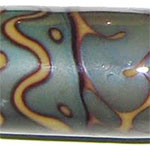
|
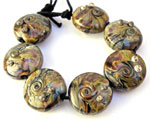
| "I made a cool discovery about Canyon de Chelly. I used some of Val Cox’s 'Ocelot Spots' frit on it, and some silvered ivory stringer, and I got some amazing hues of brown and gold. So rich!" See more at Two Glassy Ladies' blog. |
"I was curious to see how Canyon de Chelly would do as a brownish base with raku. I really like the results." Read more at Genea's blog. |
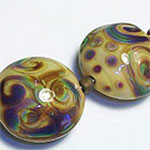
|
Canyon de Chelly with Psyche produces a spectacular effect.
– Patricia Frantz
|
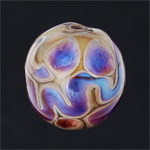
|